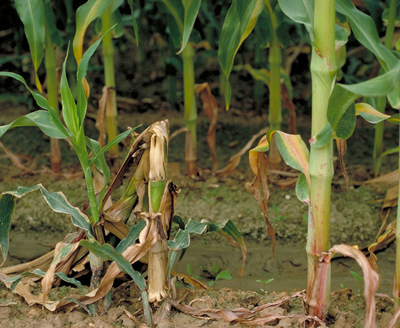
- Stalk rots cause yield loss through premature plant death, lightweight ears, and stalk lodging.
- Post-pollination stressors will pre-dispose corn to infection by stalk rot pathogens.
- Stressors include late season rains, cloudy conditions, nitrogen shortfall, and foliar disease.
- Assess fields using the pinch and push tests. Prioritize harvest where risk of lodging is highest.
What conditions lead to stalk rot problems?
Stalk rots are a recurring and common issue in corn production systems, but to a varying degree each year depending upon conditions.Stalk rots can cause yield loss in two primary ways:directly through premature plant death and lightweight ears; and indirectly through stalk lodging.Stalk rots are most troublesome when good growing conditions before pollination are followed by stressful growing conditions after pollination.Good growing conditions prior to and during pollination typically result in high kernel set, especially with hybrids specifically developed for high yield.The large number of kernels then represents an enormous carbohydrate sink in the plant, requiring a high level of photosynthesis to drive grain fill.
Any environmental stress that reduces photosynthesis in the post-pollination period can pre-dispose a corn plant to infection by stalk rot pathogens.Such stressors include high plant populations, cool weather, cloudy days, foliar disease, insect feeding on leaves and roots, compaction, low potassium fertility, nitrogen depletion, nutrient imbalances, stalk damage due to hail or insects, and under-developed root systems.The top priority of the plant is successful reproduction, and during grain fill it mobilizes carbohydrates to the kernels to ensure its own success.If the plant cannot create enough sugars in the canopy to both fill the kernels and maintain the rest of the plant, the plant will always re-mobilize carbohydrates and nutrients from the stalk to ensure reproductive success of the kernels. While stalk rot can be notoriously difficult to predict, in some areas conditions are moderately to highly favorable for stalk rot development this 2018 growing season.
How can you assess the potential for stalk rot problems?
Scout fields 40-60 days after pollination and prior to harvest to determine the potential extent of stalk rot in the farm operation.Scout out into the field and away from headland areas and check 20 stalks in 5 locations (100 stalks total).The “Pinch Test” involves pinching the stalk at the lowest node above the brace roots.If the stalk is easily crushed by hand or crunches, stalk integrity has been compromised.The “Push Test” is to push the upper part of the stalk to about 30 degrees from vertical.If the stalk lodges or fails to return to vertical, again the stalk lacks integrity.If either test reveals a 10-15% stalk rot prevalence, then that field should be prioritized for early harvest, weighing potential lodging losses against drying charges.Stack rank your lodging risk and set the harvest plan accordingly.